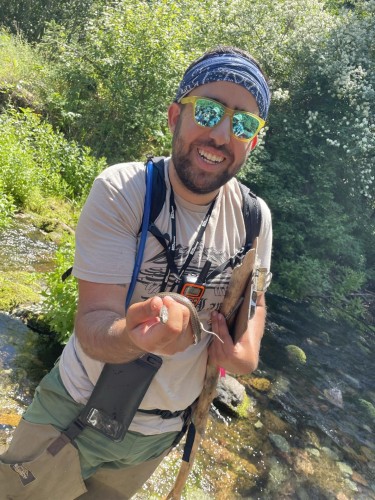Chris In The Creek: Community-Based Monitoring with the Watershed Education Network
Originally posted in the Watershed Education Network
The original blog post is available here.
 Western Montana’s Rattlesnake Creek
and its many relations – human and more-than-human – are at the
heart of our ongoing research-practice partnership between
Watershed Education Network (WEN) and the UC Davis Center for
Community and Citizen Science. As part of this partnership, I was
fortunate enough to visit Missoula this past summer to collect
data that will help us document how WEN’s Stream Team and
Backcountry Stream Corps programs are fostering community impacts
in the Rattlesnake Creek watershed and beyond.
Western Montana’s Rattlesnake Creek
and its many relations – human and more-than-human – are at the
heart of our ongoing research-practice partnership between
Watershed Education Network (WEN) and the UC Davis Center for
Community and Citizen Science. As part of this partnership, I was
fortunate enough to visit Missoula this past summer to collect
data that will help us document how WEN’s Stream Team and
Backcountry Stream Corps programs are fostering community impacts
in the Rattlesnake Creek watershed and beyond.
Both Stream Team and Backcountry Stream Corps feature community-based monitoring – a type of citizen science – as core program features. Through these efforts, local residents and volunteers are collecting biological, chemical, and physical data relating to ongoing restoration efforts in the watershed, of which the 2020 Rattlesnake Creek Dam removal was a defining feature. Ultimately, this data will be shared with partners such as Trout Unlimited and Montana Department of Fish, Wildlife, and Parks to adaptively manage the dam site in support of diverse social and ecological goals, from increasing fish passage to providing more recreational opportunities for Missoulians.
As an educational researcher, I am particularly interested in both what and how people learn through participation in community-based monitoring and other environmental activities, as well as the broader role that this learning plays in supporting a thriving future for places like Rattlesnake Creek. My research examines individuals’ relationships’ both with each other and with the natural world as resources for collective learning and change, focusing on changes in the the broader community rather than solely on what individuals gain through participating. If well-designed, citizen science activities like Stream Team and Backcountry Stream Corps have the potential to set up lifelong learning and participation in and learning about science and the environment as embedded in community and in place. Ultimately, this can support communities in working better together to address social-ecological problems like dam removal as part of civic life.
Throughout my visit to Missoula, I collected ethnographic data that we will use to describe, understand, and interpret how different people in the watershed experience and make meaning of their participation in Stream Team and Backcountry Stream Corps. On a typical day, data collection for me looked like either observations from my participation in field activities or interviews with project participants – both common methods in social science research. While observing volunteers in the field, I maintained a delicate balance of participating in the days’ activities to get a feel for the experience while also working to capture bits of conversation, landscape sketches, and descriptions of the groups’ work in my notebook. Sometimes I did this while wearing waders waist-deep in Rattlesnake Creek! Later, in the evenings and on weekends, I would process these scribbled jottings, hours of audio recordings of group conversations, and dozens of photographs into integrated narratives of each day’s happenings, with attention to how participants were engaging with each other, with the practice of science, and with the Creek. On days when I was not in the field for observations, I met with project volunteers, organizers, and scientists, ranging from high school to retirement age, for interviews. Most interviews took place at Greenough Park, where there was a natural ebb-and-flow between stories of people’s experiences participating in community-based monitoring intermixed with in-the-moment observations of the natural world around us. It was hot – so dipping our toes in the water was often a necessity, where we could also point out and observe macroinvertebrates scurrying about on the smooth rock surfaces underwater.
Central to my commitments as a researcher is working to develop research-practice partnerships with partners like WEN. This stands in contrast to conventional and sometimes extractive modes of scholarship, in which a researcher passively observes subjects as an outsider and with little engagement otherwise. Reciprocity came to be a grounding principle in my relationship with WEN. Mundane moments that might be considered external to the research process instead proved to be a core element of the experience, from giving feedback on surveys while in the office between interviews, to chatting about program goals as we drove to and from monitoring sites, to facilitating reflective discussions with volunteers to wrap up fieldwork experiences. These conversations benefitted both WEN’s programs and my research as we learned from each others’ insights and perspectives, and deepened our relationships with each other as collaborators.
Next steps for this work are to analyze all the observational and interview data, while inviting feedback from research participants, to identify what elements of WEN’s programs foster positive community impacts such as community science literacy and stewardship. These findings can be used to inform the design of community-based monitoring programs such as those at WEN, as well as the design of other informal learning environments in which scientists, educators, and local residents interact and engage with each other. We are so grateful for the opportunity to learn from WEN staff, volunteers, and partners, and look forward to sharing our findings.








